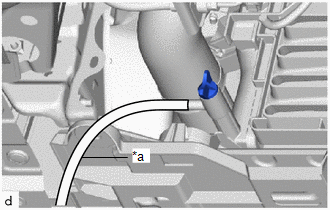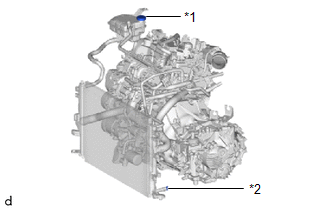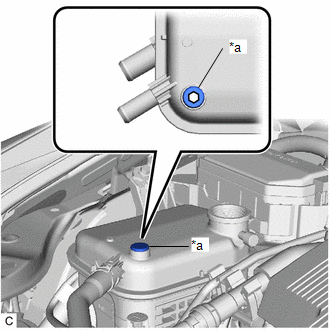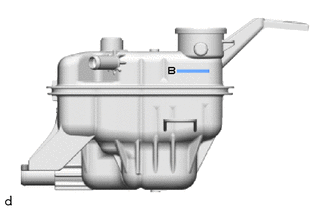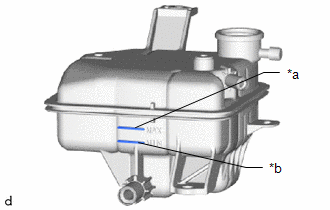Toyota Yaris: G16e-gts Coolant / Replacement
REPLACEMENT
PROCEDURE
1. SEPARATE NO. 1 ENGINE UNDER COVER ASSEMBLY
Click here

2. DRAIN ENGINE COOLANT
CAUTION:
- When engine coolant is hot, do not remove the reserve tank cap or the radiator drain cock plug.
-
Fluid and steam may spray out due to high pressure, possibly resulting in burns.
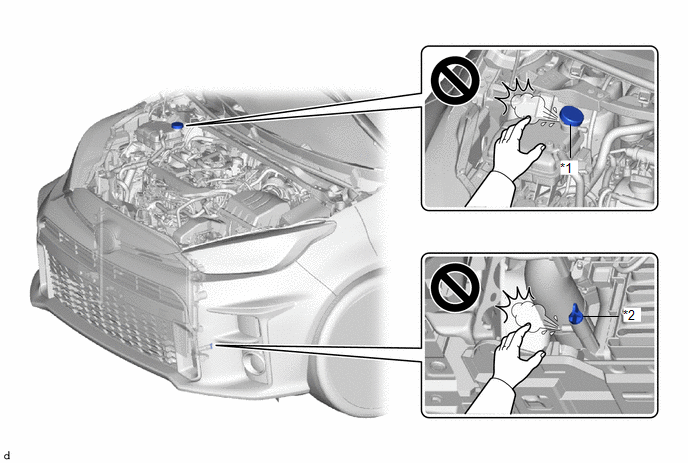
*1
Reserve Tank Cap
*2
Radiator Drain Cock Plug
| (a) Connect a hose with an inside diameter of 9 mm (0.354 in.) to the radiator drain cock as shown in the illustration. |
|
(b) Loosen the radiator drain cock plug.
| (c) Remove the reserve tank cap. Then drain the engine coolant. HINT: Collect the engine coolant in a container and dispose of it according to the regulations in your area. |
|
(d) Tighten the radiator drain cock plug by hand.
(e) Disconnect the hose from the radiator drain cock.
3. ADD ENGINE COOLANT
| (a) Using a 6 mm hexagon socket wrench, remove the air release valve from the radiator reserve tank assembly. |
|
| (b) Add engine coolant to the level shown in the illustration. Standard Capacity: 5.2 liters (5.5 US qts, 4.6 Imp. qts) NOTICE: Do not substitute plain water for engine coolant. HINT: TOYOTA vehicles are filled with TOYOTA SLLC at the factory. In order to avoid damaging the engine cooling system and other technical problems, only use TOYOTA SLLC or similar high quality ethylene glycol based non-silicate, non-amine, non-nitrite, non-borate coolant with long-life hybrid organic acid technology (coolant with long-life hybrid organic acid technology is a combination of low phosphates and organic acids). |
|
(c) Using a 6 mm hexagon socket wrench, install the air release valve to the radiator reserve tank assembly.
Torque:
2.0 N·m {20 kgf·cm, 18 in·lbf}
(d) Install the reserve tank cap.
NOTICE:
Securely tighten the reserve tank cap as much as possible.
(e) Bleed air from the cooling system.
NOTICE:
- Before starting the engine, turn the A/C switch off.
- Adjust the heater control to the maximum hot setting.
- Adjust the blower speed to the low setting.
(1) Warm up the engine until the thermostat opens. While the thermostat is open, circulate the engine coolant for several minutes.
HINT:
The thermostat open timing can be confirmed by squeezing the No. 2 radiator hose by hand, and sensing vibrations when the engine coolant starts to flow inside the No. 2 radiator hose.
(2) After the engine has warmed up, run the engine using the following cycle for at least 7 minutes: at 3000 rpm for 5 seconds, at idle speed for 45 seconds. (Repeat this cycle at least 8 times.)
(3) Squeeze the No. 1 radiator hose and No. 2 radiator hose several times by hand to bleed air from the system.
CAUTION:
When squeezing the No. 1 radiator hose and No. 2 radiator hose:
- Wear protective gloves.
- Be careful as the No. 1 radiator hose and No. 2 radiator hose are hot.
- Keep your hands away from the fan.
NOTICE:
- If the coolant temperature gauge indicates an excessive temperature, turn off the engine and let it cool.
- Make sure that the radiator reserve tank assembly still has some engine coolant in it.
- If the radiator reserve tank assembly does not have enough engine coolant, the engine may overheat or be seriously damaged.
- If the radiator reserve tank assembly does not have enough engine coolant, perform the following: 1) stop the engine, 2) wait until the engine coolant has cooled down, and 3) add engine coolant until the radiator reserve tank assembly is filled to the FULL line.
HINT:
If the flowing sound of engine coolant can still be heard after bleeding air, perform the following procedure to bleed air again.
- Warm up the engine. (With the engine idling, check that the engine coolant is flowing into the radiator reserve tank assembly.)
- Run the engine at 2000 rpm for 2 minutes or more. (A)
- Leave the engine idling for 2 minutes or more. (B)
- Repeat steps (A) and (B) 4 times or more.
| (f) After the engine has cooled down, check that the engine coolant level is between the MAX and MIN lines. NOTICE: The engine coolant levels in the compartments inside the radiator reserve tank assembly may differ, but this is not a malfunction. If the engine coolant level is below the MIN line, add engine coolant to the MAX line. |
|
4. INSPECT FOR COOLANT LEAK
Click here

5. INSTALL ENGINE UNDER COVER ASSEMBLY NO.1
Click here

 Components
Components
COMPONENTS ILLUSTRATION
*1 RESERVE TANK CAP *2 RADIATOR DRAIN COCK PLUG *3 NO. 1 ENGINE UNDER COVER ASSEMBLY - -
N*m (kgf*cm, ft...
 G16e-gts Drive Belt
G16e-gts Drive Belt
ComponentsCOMPONENTS ILLUSTRATION
*1 FAN AND GENERATOR V BELT *2 ENGINE UNDER COVER RH *3 NO. 1 ENGINE UNDER COVER ASSEMBLY - -
N*m (kgf*cm, ft...
Other information:
Toyota Yaris XP210 (2020-2025) Reapir and Service Manual: Removal
REMOVAL CAUTION / NOTICE / HINT HINT: When the cable is disconnected / reconnected to the auxiliary battery terminal, systems temporarily stop operating. However, each system has a function that completes learning the first time the system is used. Learning completes when vehicle is driven Effect/Inoperative Function When Necessary Procedures are not Performed Necessary Procedures Link Lane tracing assist system Drive the vehicle straight ahead at 35 km/h (22 mph) or more for 5 second or more...
Toyota Yaris XP210 (2020-2025) Reapir and Service Manual: Lost Communication with Steering Angle Sensor Module Missing Message (U012687,U010087,U012987,U014087,U023A87)
DESCRIPTION The power steering ECU assembly receives signals from the steering sensor, skid control ECU (brake actuator assembly), forward recognition camera, ECM and clearance warning ECU assembly via CAN communication. DTC No. Detection Item DTC Detection Condition Trouble Area Warning Indicate Return-to-normal Condition Note U010087 Lost Communication With ECM/PCM "A" Missing Message Lost communication with ECM CAN communication system ECM EPS warning light: Does not come on After normal confirmation - U012687 Lost Communication with Steering Angle Sensor Module Missing Message Lost communication with steering sensor CAN communication system Steering sensor EPS warning light: Does not come on After normal confirmation - U012987 Lost Communication with Brake System Control Module Missing Message Lost communication with skid control ECU (brake booster with master cylinder assembly) CAN communication system Skid control ECU (Brake booster with master cylinder assembly)(for TMC Made HV Model) Skid control ECU (Brake actuator assembly)(for TMMF Made HV Model) EPS warning light: Does not come on After normal confirmation - U014087 Lost Communication with Body Control Module Missing Message Lost communication with main body ECU (multiplex network body ECU) CAN communication system Main body ECU (multiplex network body ECU) EPS warning light: Does not come on After normal confirmation - U023A87 Lost Communication with Image Processing Module "A" Missing Message Lost communication with forward recognition camera CAN communication system Forward recognition camera EPS warning light: Does not come on After normal confirmation w/ Toyota Safety Sense PROCEDURE 1...
Categories
- Manuals Home
- Toyota Yaris Owners Manual
- Toyota Yaris Service Manual
- Opening and Closing the Liftgate/Trunk Lid
- Brake System Control Module "A" System Voltage System Voltage Low (C137BA2)
- How to connect USB port/Auxiliary jack
- New on site
- Most important about car
Supplemental Restraint System (SRS) Precautions
The front and side supplemental restraint systems (SRS) include different types of air bags. Please verify the different types of air bags which are equipped on your vehicle by locating the “SRS AIRBAG” location indicators. These indicators are visible in the area where the air bags are installed.
The air bags are installed in the following locations:
The steering wheel hub (driver air bag) The front passenger dashboard (front passenger air bag) The outboard sides of the front seatbacks (side air bags) The front and rear window pillars, and the roof edge along both sides (curtain air bags)
